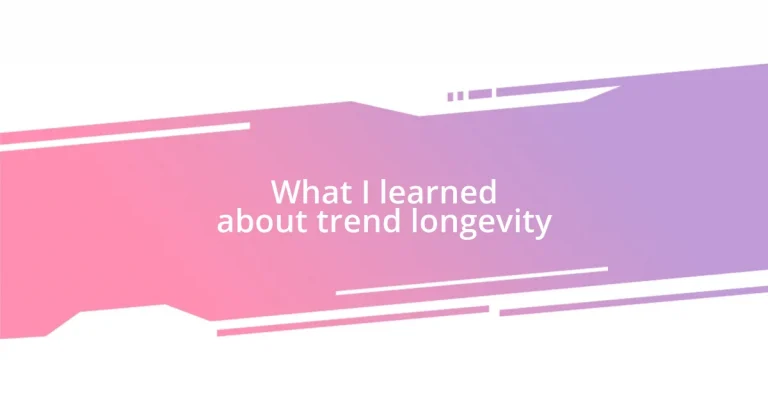Key takeaways:
- Trend longevity is influenced by factors such as cultural relevance, emotional connection, adaptability, quality, and community support.
- Emerging trends often reflect societal shifts, like mindfulness and self-care, highlighting the need for community engagement and shared experiences.
- Leveraging trends effectively involves timing, storytelling, and maintaining authenticity to build lasting connections with the audience.
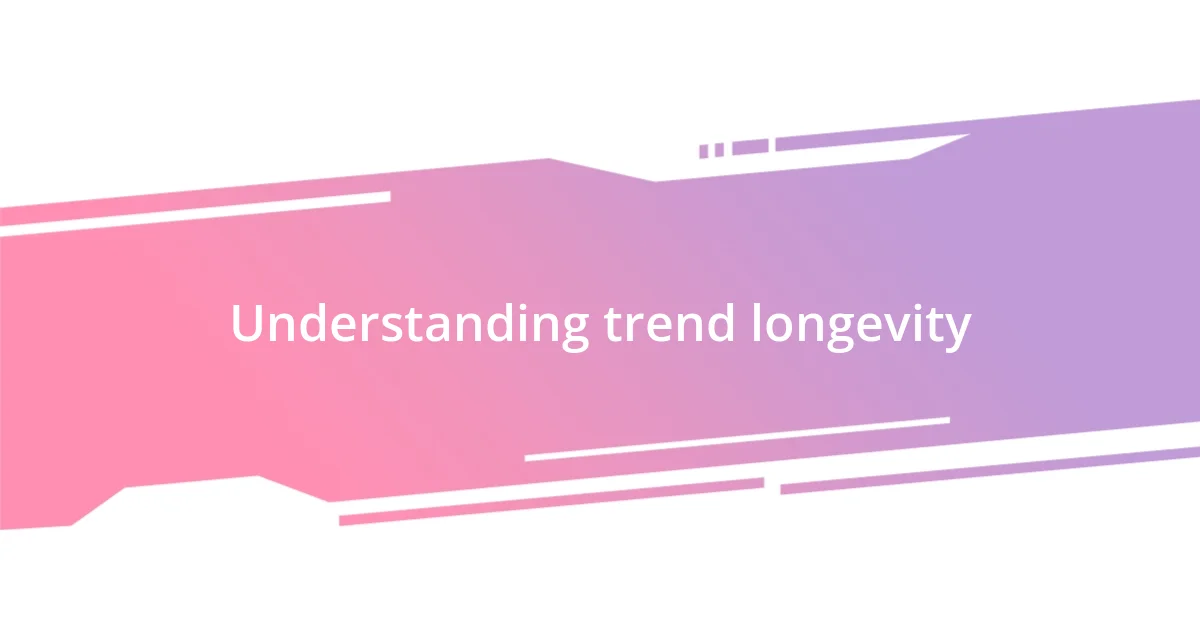
Understanding trend longevity
Understanding trend longevity is really about discerning which trends have the potential to stand the test of time. I often find myself reflecting on past styles—like the resurgence of vintage denim—and wondering what keeps them relevant. It’s not just about aesthetics; it’s about emotion and connection, too.
I remember a time when minimalism surged in popularity. It felt freeing to declutter and simplify my space, but I realized that trends like this tend to resonate deeply with changing lifestyles and values. So, I ask myself: why do some trends fade while others become mainstays? It often boils down to deeper societal shifts and the emotional connections people forge with these trends.
At times, I’ve watched trends adapt and evolve rather than die out completely. For example, the rise of sustainability in fashion speaks to our growing awareness of environmental issues. When a trend aligns with a core value, it seemingly transforms into something much more enduring. What trends do you think are here to stay, and how do they resonate with your values?
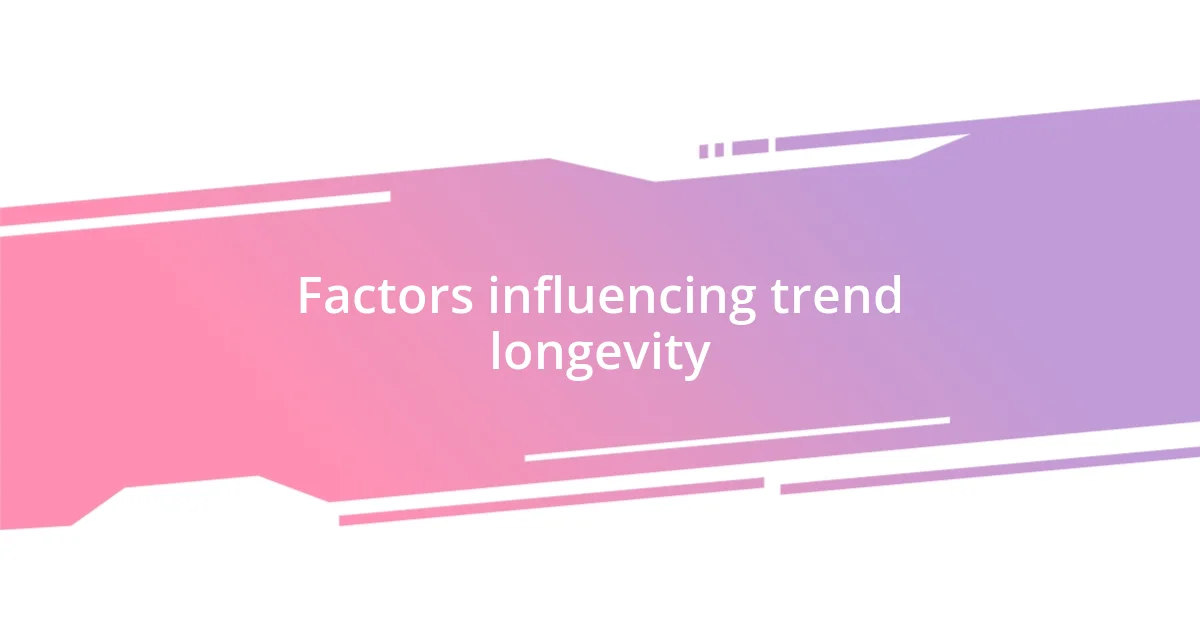
Factors influencing trend longevity
When considering what makes a trend last, several key factors come into play. I’ve often noticed that a trend’s adaptability significantly influences its lifespan. For instance, think about how streetwear has evolved over the years. It started in niche communities but pivoted to embrace high fashion, showing that flexibility keeps something fresh and relevant.
Here are some significant factors influencing trend longevity:
- Cultural Relevance: Trends that reflect important societal issues or collective sentiments often gain traction and stay relevant longer.
- Emotional Connection: If a trend resonates emotionally—like the nostalgia tied to retro revival—it tends to be cherished, ensuring its continued presence.
- Adaptability: The ability of a trend to morph and fit various lifestyles can keep it alive. For instance, athleisure evolved from specific athletic wear to everyday outfits.
- Quality and Sustainability: Trends tied to high-quality or sustainable practices appeal to today’s conscientious consumers.
- Community Support: When a community rallies around a trend—think of local craftsmen or small businesses—its likelihood of enduring increases dramatically.
Ultimately, these factors create a landscape where certain trends thrive while others fizzle out, based on the emotional and practical connections we forge with them.

Analyzing past trends
Analyzing past trends allows us to discern patterns that can illuminate why some styles linger while others fade into obscurity. Reflecting on the 90s grunge movement, I remember how it was not just about the flannel shirts and combat boots; it encapsulated a spirit of rebellion and differentiation. When a trend encapsulates a significant cultural moment, it often finds its way back, like those iconic Doc Martens making a comeback today.
I have often marveled at how trends like bohemian style have evolved over decades. Initially rooted in the countercultural movement, its core elements—think of flowing fabrics and vibrant colors—still resonate deeply with a desire for freedom and self-expression. This ability to shift while maintaining the original sentiment is a fascinating aspect of trend longevity that deserves examination. Trends that retain their fundamental message, but adapt to new contexts, showcase resilience and relevance through time.
To contextualize this further, analyzing a few notable past trends can highlight common threads in their evolution and sustainability. Reflecting back on how disco influenced modern pop culture reminds me of how music trends mirror social change—each remnant of the past informs something new and vibrant in the present. I find it essential to explore how these threads interweave, ultimately shaping our cultural narrative.
| Trend | Decade |
|---|---|
| Disco | 1970s |
| Grunge | 1990s |
| Bohemian | 1960s-Present |
| Minimalism | 2000s-Present |

Identifying emerging trends
Identifying emerging trends often feels like a thrilling treasure hunt. I remember browsing through social media during a late-night scroll and discovering the rising popularity of self-care routines. It made me think — why are people so drawn to this now? I realized that in a fast-paced world, where stress is prevalent, the push for mindfulness and self-love resonates deeply with many, indicating a larger societal shift.
Another crucial element is observing how communities come together around specific practices. I once stumbled upon a local market bursting with plant enthusiasts, all sharing tips on urban gardening. This collective excitement showcased not just a trend, but a movement towards sustainability and connection with nature. It made me wonder—how many of us are looking for tangible ways to foster community?
With my experiences in trend forecasting, I’ve found that youth-driven platforms like TikTok often serve as crystal balls for the future. A recent dance challenge or quirky DIY project can explode overnight, leaving me pondering how these seemingly simple moments connect generations. The power of creativity and collaboration on such platforms means they can act as a breeding ground for trends, allowing them to emerge and spread faster than ever before.
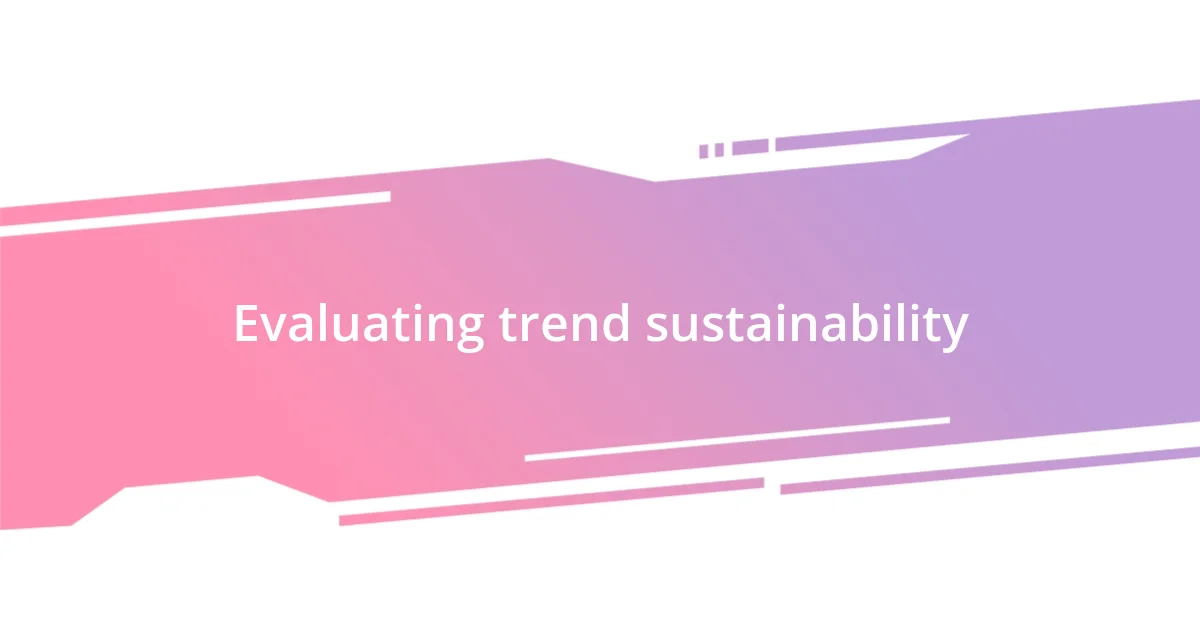
Evaluating trend sustainability
Evaluating the sustainability of a trend requires looking beyond its immediate appeal. I recall when I first noticed the resurgence of vintage fashion at local thrift stores; it was more than just a trend—it embodied values of sustainability and individuality. This brings up an important question: what makes a trend endure? It’s about connecting deeply with the values and emotions of the time.
As I observe ongoing shifts in consumer behavior, I see that successful trends often spark conversations and foster community. For instance, the way people gathered to share recipes during the rise of plant-based diets was akin to forming a virtual support group. Have you noticed how trends that involve collaboration or shared experiences tend to grow more robustly? It’s a reminder that sustainability isn’t just about the product; it’s about the connections it forges.
On a more personal note, I sometimes reflect on events that have sparked lasting movements. One striking example for me was the global response to climate change; it brought people together like nothing I’ve ever seen. It makes me think about the life span of trends tied to important issues—can they outlast their moment in the spotlight? I believe those rooted in substantial cultural concerns tend to have a longer shelf life, adapting and evolving meaningfully with time.
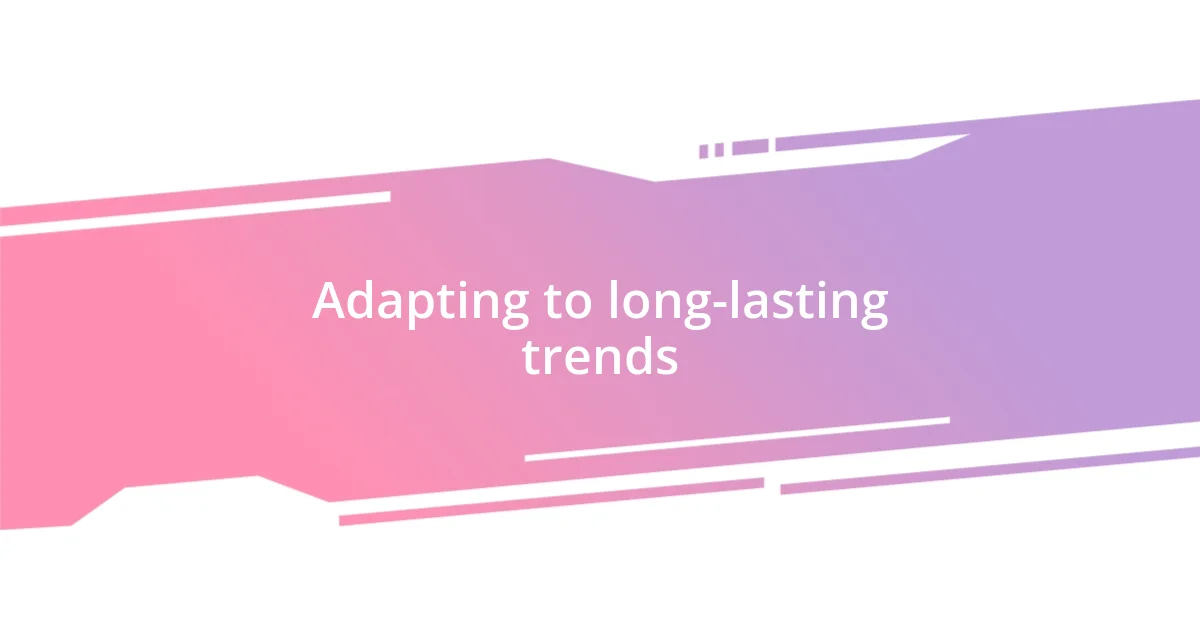
Adapting to long-lasting trends
Adapting to long-lasting trends requires us to remain flexible while staying true to what resonates deeply. I vividly remember a time when my favorite coffee shop began promoting zero-waste practices. At first, it felt like a gimmick, but as I started incorporating these ideas into my routine, I understood—it was about a lifestyle shift. Have you ever noticed how embracing a trend can alter your daily habits in meaningful ways?
I’ve found that the key to adapting is being observant and willing to experiment. For example, I experimented with digital detox weekends after hearing friends rave about the clarity it brought them. The first few attempts were challenging, yet I discovered the immense value of disconnecting from constant notifications. This shift sparked my creativity and allowed me to reconnect with my passions—like painting and reading. Isn’t it fascinating how sometimes a trend can lead us back to ourselves?
Moreover, I often think about the cyclical nature of trends. When I first started exploring the farm-to-table movement, I was skeptical. It wasn’t until I visited a local farm and shared a meal with the growers that I truly grasped its significance. The experience taught me that adapting to trends isn’t just about consuming—they require engagement and understanding. How can we truly adapt if we don’t dive deeper into what the trend embodies? It’s these connections that make a trend not only relevant but deeply enriching.
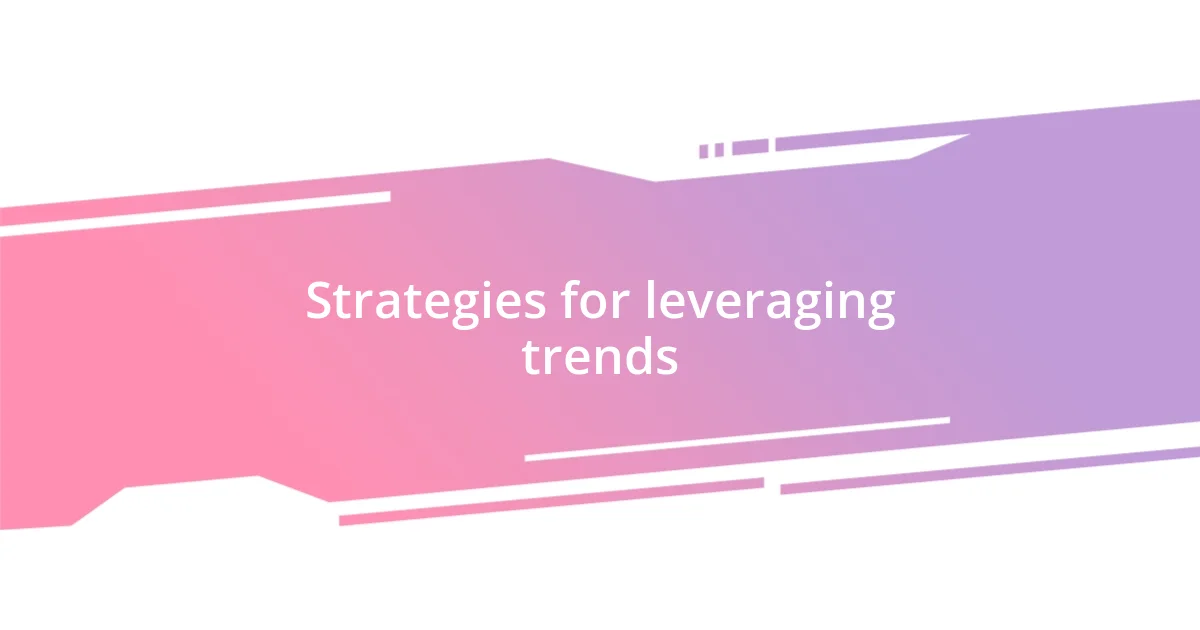
Strategies for leveraging trends
When it comes to leveraging trends, I’ve learned that timing and execution are crucial. I still remember how a local brand launched a limited-edition collection tied to a viral social media challenge. They not only capitalized on the moment but also tapped into a larger story that resonated with their audience. Have you ever felt that rush when a product perfectly aligns with a trending topic? It really showcases the power of being in tune with what your audience cares about.
I believe a great strategy is to engage your community through storytelling. For instance, I once joined a campaign where participants shared their personal sustainability journeys, creating a mosaic of shared experiences. This not only boosted engagement but also built an emotional connection between the brand and its audience. Isn’t it incredible how stories breathe life into trends, transforming them from fleeting moments into lasting movements?
Another tactic I’ve found effective is to maintain authenticity while adapting to trends. There was a time when I watched a beloved brand overreach by jumping on too many trends, causing their message to dilute. Striking a balance between staying relevant and remaining true to core values is key. How can brands evolve without losing sight of what makes them unique? It’s this authenticity that keeps a trend from feeling like a passing phenomenon and instead anchors it in genuine connection.












